GAME CHANGERS: TECH&LEARNING’S 2017 LIST OF MOST INFLUENTIAL PEOPLE IN EDTECH
ANSHUL BHAGI
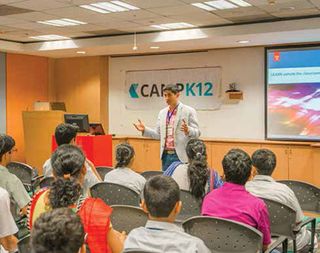
Anshul Bhagi wants to figure out how to provide access to high-quality learning without compromising its quality. “In the last few years we’ve seen the rise of several platforms that I admire—MOOCs, Khan Academy, edX—but we took out the one thing that makes education great: interactivity. Because we couldn’t scale good teachers, we used pre-recorded video instead.” Bhagi, who during his undergraduate years at MIT taught at schools in Brazil, Italy, Kenya, and China, noticed that too much of today’s content is irrelevant and uninspiring. Even in the United States, when he was in high school in the Silicon Valley, he learned more math and science by teaching himself Java and creating games than he did from any of his textbooks. After graduate school, he decided to teach game programming to students in his homeland of India and launched Camp K12. “I hired young people as instructors, and we partner with progressive principals and superintendents in four different cities to bridge the gaps in the Indian curriculum.” For now, the classes are face to face because Bhagi believes that is currently the best way to learn. However, he is determined to solve the puzzle of how to teach hands-on topics online without losing interactivity, accountability, and motivation. “It has to be more than a passive, pre-recorded video,” he says. “I know we can make this happen.”
JOSÉ M. TORRES
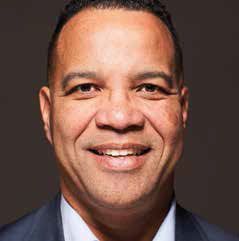
“Over the years, educators have anticipated the ‘killer app’ for education,” says José M. Torres, president of the Illinois Mathematics and Science Academy (IMSA). “While we wait for the ‘Facebook of education,’ some of us have been closely observing what is happening with advanced exponential technologies such as artificial intelligence, robotics, biotechnology, nanotechnology, additive manufacturing, and the Internet of Things.” Torres is not just observing those technologies; he’s helping students solve the world’s challenges by delivering a competency-driven STEM-infused curriculum with inquiry-based learning, problem-centered learning, and integrative learning experiences. In the fall, for the second year in a row, IMSA will offer free, dedicated space for early-stage edtech startups inside its 6,400-square-foot tech and innovation center. Dropdot, a connect-thedots early childhood literacy app developed by a team of IMSA seniors in 2016-2017, is available on Google Play. “I expect the future of education and edtech to be both fascinating and surprising, filled with the unexpected and unanticipated,” he says. “The question of content and learning processes, such as learning how to learn, will increasingly be more important. For example, what do we teach students when Google knows everything?”
GABO ARORA
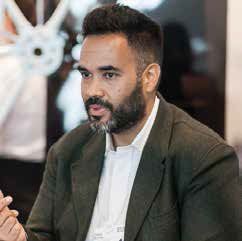
If you’re intrigued by virtual reality (VR) but not sure about its value in education, Gabo Arora is your man. As founder and president of LightShed, a VR and social impact startup, Arora creates VR documentaries about social causes. He also served as the United Nations’ first-ever creative director, where he produced a VR film series about people in crisis, including Clouds over Sidra, about daily life at a refugee camp in Jordan, and Waves of Grace, the story of an Ebola survivor who takes care of orphans in Liberia. These days, he focuses on using technology to promote social causes and he developed a viral video campaign for the climate change summit. In an interview for the Stanford Social Innovation Review in April, Arora admitted that although he works with the latest gear, his five-year-old son attends a Waldorf School and does not know what an iPad is. He also confessed to turning off his router at night to unplug from the never-ending barrage of information. Arora says his mission is to use storytelling to “instill not only a better understanding about the problems but also empathy for the people enduring them.” Sounds like a great reason to bring VR into the classroom.
BETSY DEVOS
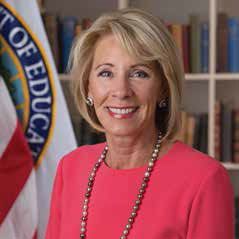
While many of President Trump’s cabinet appointees inspired healthy debate, his choice for US Education Secretary, Betsy DeVos, drew a significant amount of criticism. A long-time school choice activist, DeVos comes to the table with very defined beliefs. She is anti-Common Core, pro-voucher, and deeply enamored with charter schools. In fact, she and her husband started the Great Lakes Education Project, a bipartisan advocacy group whose mission is to “improve academic achievement, increase accountability, and empower parental choice in our [Michigan] schools.” In a 2013 interview for Philanthropy magazine, DeVos discussed becoming committed to helping low-income parents select the right schools for their children and how that led her to begin serving on boards that expanded educational choice through vouchers and tax credits. Later in the interview, she spoke favorably about technology in education, giving props to digital learning and the power of technology to make learning engaging and accessible. In May, during her keynote at ASU+GSV Summit, DeVos didn’t divulge much more about her plans, simply saying that education delivery should be diverse and asking the audience how they would redesign our educational system. Regarding edtech, she said, “…[W]e have not yet realized the full range of technology’s power and ability to help students learn.”
RICHARD CULATTA

In our edtech world, Richard Culatta is pretty much a household name. From 2012 through 2015, he was director of the Office of Educational Technology for the US Department of Education, where he focused on expanding broadband connectivity, increasing personalized learning, and boosting open educational resources. After that, he became Rhode Island’s first chief innovation officer, helping to develop a statewide 5G wireless network, starting a free textbook program, and trying to increase computer science courses. This May, Culatta returned to the national spotlight as ISTE’s chief executive officer. “One of the reasons I wanted to come to ISTE was to engage educators around key issues in education where technology can help provide solutions, such as closing long-stemming equity gaps and rethinking the future of assessment,” he says. Culatta plans to empower ISTE members by describing the steps they can take to make an impact in their schools and communities. He’s also looking forward to engaging with the higher education community and helping them think about using technology to build on K-12’s foundational work. “From managing schools to delivering curriculum to training teachers, any part of education has a technology component. It’s less about tools and apps and more about how we can use technology to solve tough problems across a whole variety of issues.”
JOSEPH QUALLS
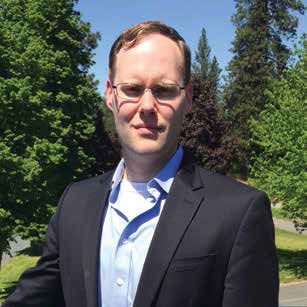
No one was more surprised than Joseph Qualls when the military reached out to him in 2005. As the founder of RenderMatrix, a high-end cybersecurity firm, Qualls was getting a name for his artificial intelligence (AI) work and the military wanted to be connected with university researchers who could help develop an AI product to eliminate deaths from improvised explosive devices. “I became known as the guy who asked a lot of crazy questions to get the AI to work correctly,” says Qualls. Through his university work, he saw that both K-12 and higher-ed curricula are not preparing today’s generation for the workforce, so he decided to lend a helping hand. “Ideally, you want 20 students to one university instructor per semester, but professors are teaching classes of 400 to 500 students. That’s where AI can help.” According to Qualls, AI can generate a profile of each child, detailing likes, dislikes, and quirks, in order to guide and monitor a student and deliver a personalized learning experience. “What if an AI system could begin to personalize education as early as kindergarten?” he asks. “If today’s graduates are no longer ready to go to college or work, we need to go back to basics and figure out what is missing. If you do nothing else, bring in more hands-on projects—not just in physics but in all classes.”
CLAIRE BOONSTRA

Claire Boonstra is excited but wary about the surge of interest in education. “Lately there’s a gigantic boom, but we are building a new world on an old foundation. We keep sticking to the same old success factors of higher scores, higher rankings. But we have to adopt a completely different paradigm,” she says. Boonstra, who lives in the Netherlands and has been an engineer, a marketing manager, and an augmented reality startup cofounder, has a new job for her CV: helping others see the need to reboot education. She is concerned that we are merely adding technology to the existing educational system, rather than asking questions such as: What is really important? How can technology lead us there? In September, 2012, after sharing her vision about education at TEDx-AmsterdamED, Boonstra began her effort to revolutionize education. She started a nonprofit foundation called Operation Education, through which she creates frameworks and connects people around education reform. Her team helps schools figure out how they can better serve their learners and society by discussing questions such as these: Why do we have classrooms and lesson plans? Why do we give grades? As Boonstra says, “There is very little scientific evidence that what we are doing right now is the right thing for learners or society. It simply ended up this way, and we don’t even question the habits. If you think about the number of lives being impacted by school leaders, you realize they are the most important people in this world. We should treat them that way and help them be the best they can be.”
NAMIT BHATIA
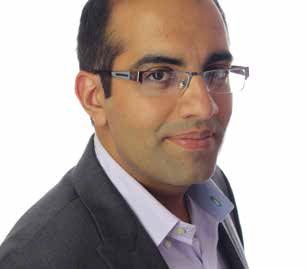
Namit Bhatia runs Crescerance, which develops websites and mobile apps for school districts, and MAD-learn, a Web-based coding curriculum used globally for app development. In his previous life, Bhatia worked in financial technology. Why the change? Five years ago, after hearing a keynote by Condoleezza Rice in which she said that more than 50 percent of children in 46 states are on free/reduced lunch, Bhatia began to consider education as a next career step. He offered to help his wife, who started Crescerance, scale the business for six months. After four years, he hasn’t left. “In education, you find passion and genuine caring,” he says. Bhatia believes that companies like his need to solve two key challenges. The first is about infrastructure, or making sure that every school has the facilities, technology, and framework for decision making, communications, analytics, etc. The second challenge is about what happens in the classroom itself, including curriculum, making teaching attractive, and creating a facility to improve teaching. “If we want children to be better managers of the process of building technology and building businesses, we must teach them about entrepreneurship as early as we can. If this is the world we’re moving toward, let’s prepare children to live and succeed in that world.”
SUZ SOMERSALL

Suz Somersall was turned off by her undergraduate engineering courses, but she fell in love with the subject during graduate school at the Rhode Island School of Design. “3D printers, laser cutters, CNC milling machines, and engineering software allowed me to bring my imagination to life,” she says. Because of what she experienced, she’s determined to make engineering fun and meaningful for everyone else. And luckily for the rest of the world, she started a company to do just that. At KiraKira3D, she and her all-female team of engineers promote STEAM education for everyone, with a focus on young women. The company offers free online classes to learn how to make everything from a skateboard to a skirt to an iPhone case. Users earn points toward future purchases by taking classes and/or selling their creations. The brand new KiraKira3D modeling app lets people create, share, and print designs from their phones. Not too surprisingly, the site is growing exponentially: In 2016, there were 100,000 users; this year that number will go to two million. “We are passionate about getting middle-school-age girls excited about STEAM and creating something they love. We’d like to entice as many girls as we can to get a STEM degree and a high-paying STEM career.”
SELENA GOMEZ

Surprised to see Selena Gomez on this list? You shouldn’t be. The celebrity has 120 million Instagram followers and is a social media legend. She was also one of the leading forces behind this year’s most-talked-about series, 13 Reasons Why. Back in April, you couldn’t go an hour without hearing people discussing the Netflix show. Facebook feeds were filled with news articles and letters from K-12 administrators urging parents to preview the show to decide if their children should watch it. In case you weren’t online this spring, the series is based on a young adult novel about a 17-year-old girl who commits suicide and leaves behind audio recordings for 13 people who she felt contributed to her decision to end her life. Gomez, who was executive producer of the series, told Hollywood Reporter in February that when production started she was in rehab for anxiety and depression and met “tons of kids who were talking about a lot of the issues that these characters are experiencing.” In the same interview, she confessed to taking time off from social media in order to maintain her health and happiness. However, like any role model, she knows that avoiding social media is impossible and hopes that 13 Reasons Why will help teenagers talk about their experiences and understand why suicide is not the answer. As she said, “I would do anything to be able to have a good influence on this generation, but I definitely relate to everything that was going on.”
Tech & Learning Newsletter
Tools and ideas to transform education. Sign up below.











